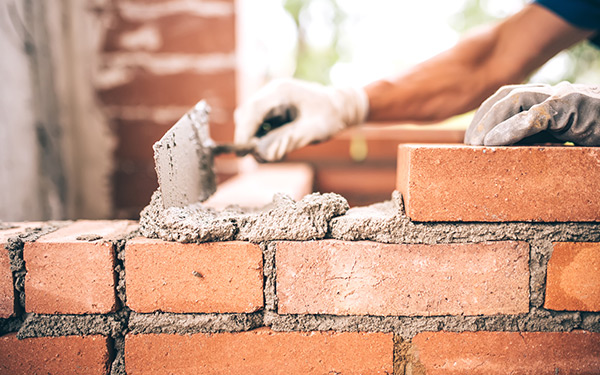Opening the Keys of Lasting Masonry Construction Practices for Eco-Friendly Buildings
In the realm of modern construction, the pursuit of lasting techniques has become extremely important. Amongst the myriad methods to environmentally friendly building, lasting masonry building and construction stands out as a reliable and resilient approach that holds a riches of untapped potential. From the option of materials to cutting-edge construction strategies, the secrets to accomplishing sustainability within stonework building are multifaceted and fascinating. By exploring the advantages, materials, techniques, and future fads of sustainable stonework, a deeper understanding of how these practices can form the future of environment-friendly buildings emerges.
Benefits of Lasting Masonry Construction
Welcoming sustainable masonry building and construction methods not only lowers ecological effect however also supplies long-lasting economic advantages to contractors and communities. By utilizing products like recycled bricks, obstructs, and stones, builders can dramatically reduce the carbon impact of their tasks while advertising resource efficiency. Furthermore, lasting masonry building and construction methods, such as proper insulation and thermal mass residential or commercial properties, can boost energy effectiveness within structures, causing reduced operational costs over time.
Additionally, the sturdiness and strength of masonry structures add to long-term financial advantages. Structures constructed utilizing lasting stonework practices commonly require less repair and maintenance, translating to cost savings for contractors and residential or commercial property owners. The durability of stonework products additionally ensures that structures continue to be stable and protected, decreasing the requirement for regular improvements or replacements.
Eco-Friendly Masonry Products
Making use of environment-friendly stonework materials is an essential action in the direction of enhancing the sustainability of building methods and lessening ecological influence while making best use of long-term economic advantages. Sustainable masonry materials are sourced, produced, and made use of in a fashion that lowers overall environmental impact. Products such as recycled blocks, recovered stone, and lasting cinder block are becoming progressively popular selections for eco-conscious builders. Recycled blocks, as an example, not only divert waste from garbage dumps however also call for much less energy to generate contrasted to new bricks. Reclaimed rock uses a special aesthetic appeal while lowering the demand for brand-new quarrying. Lasting concrete blocks incorporate recycled accumulations and may feature better insulation residential or commercial properties, adding to power effectiveness in structures.
Additionally, all-natural products like adobe, rammed earth, and straw bales supply superb thermal mass buildings, lowering the need for heating and cooling down power. These products are frequently locally readily available, advertising regional economic climates and lowering transportation-related carbon emissions. By choosing eco-friendly masonry materials, construction jobs can significantly reduce their environmental footprint and add to the development of healthier, extra sustainable built environments.
Energy-Efficient Masonry Techniques
Energy effectiveness plays a crucial role in improving the sustainability of masonry construction methods. By carrying out energy-efficient stonework strategies, builders can substantially decrease the total power usage of a building, resulting in lower functional expenses and a smaller ecological impact. One essential energy-efficient masonry strategy is making use of thermal mass, which includes incorporating thick materials like concrete or block right into the building's framework to soak up and keep heat. This aids control indoor temperatures, reducing the demand for mechanical home heating and cooling systems.

Innovations in Lasting Masonry
Recent developments in sustainable stonework methods have produced innovative strategies that are improving the building market. One such development is the development of self-healing concrete, which makes use of microorganisms embedded within the concrete to recover splits autonomously. This development not only lowers maintenance costs yet likewise enhances the longevity of stonework structures, adding to their sustainability.
One more remarkable advancement is making use of recycled accumulations in masonry construction - masonry contractor. By integrating materials such as smashed ceramic waste or recycled glass into concrete mixes, contractors can lower the environmental effect of building jobs while keeping structural honesty. This practice not just draws away waste from landfills yet additionally saves all-natural resources, making it a crucial improvement in lasting masonry building
Furthermore, the integration of electronic layout tools, such as Building Details Modeling (BIM), is revolutionizing the method masonry frameworks are intended and constructed. BIM enables cinder block price for even concrete stamp rental near me more specific calculations, minimized product waste, and boosted power efficiency, ultimately resulting in even more lasting structure techniques. These technologies collectively represent an appealing future for lasting stonework building in the period of environmentally friendly buildings.
Future Trends in Stonework Sustainability
With the innovative strides made in sustainable masonry practices, the future trends in masonry sustainability are poised to further revolutionize the construction sector. One of the essential patterns shaping the future of masonry sustainability is the increased integration of innovation. Developments such as Structure Info Modeling (BIM) and online reality simulations are being utilized to optimize stonework building and construction procedures, leading to reduced product waste and enhanced energy efficiency in structures.
Moreover, the advancement of unique lasting materials is set to play a significant duty in boosting the eco-friendliness of masonry construction. masonry contractor. Technologies like self-healing concrete, recycled aggregates, and bio-based binders are gaining grip for their capability to minimize ecological effect while maintaining architectural integrity

Verdict
Finally, lasting masonry building methods use countless advantages for eco-friendly buildings. By utilizing green products and energy-efficient strategies, stonework can add to an extra lasting developed atmosphere. Developments in lasting stonework are continually being created to additionally improve the environmental performance of structures. description Looking in the direction of the future, the pattern of stonework sustainability is anticipated to grow, resulting in even more eco-friendly and energy-efficient building practices in the years ahead.